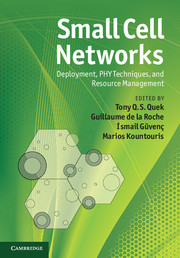Book contents
- Frontmatter
- Contents
- List of contributors
- Foreword by David Chambers
- Acknowledgments
- Acronyms
- 1 Small cell networks overview
- 2 Fundamentals of access control in femtocells
- 3 Coverage analysis using the Poisson point process model
- 4 Interference modeling for cognitive femtocells
- 5 Multiple antenna techniques in small cell networks
- 6 Physical layer techniques for cognitive femtocells
- 7 Femtocell coverage optimization
- 8 Random matrix methods for cooperation in small cell networks
- 9 Mobility in small cell networks
- 10 Cognitive radio resource management in autonomous femtocell networks
- 11 Decentralized reinforcement learning techniques for interference management in heterogeneous networks
- 12 Resource allocation optimization in heterogeneous wireless networks
- 13 New strategies for femto-macro cellular interference control
- 14 Femtocell interference control in standardization
- 15 Spectrum assignment and fairness in femtocell networks
- 16 Self-organization and interference avoidance for LTE femtocells
- Index
- References
9 - Mobility in small cell networks
Published online by Cambridge University Press: 05 May 2013
- Frontmatter
- Contents
- List of contributors
- Foreword by David Chambers
- Acknowledgments
- Acronyms
- 1 Small cell networks overview
- 2 Fundamentals of access control in femtocells
- 3 Coverage analysis using the Poisson point process model
- 4 Interference modeling for cognitive femtocells
- 5 Multiple antenna techniques in small cell networks
- 6 Physical layer techniques for cognitive femtocells
- 7 Femtocell coverage optimization
- 8 Random matrix methods for cooperation in small cell networks
- 9 Mobility in small cell networks
- 10 Cognitive radio resource management in autonomous femtocell networks
- 11 Decentralized reinforcement learning techniques for interference management in heterogeneous networks
- 12 Resource allocation optimization in heterogeneous wireless networks
- 13 New strategies for femto-macro cellular interference control
- 14 Femtocell interference control in standardization
- 15 Spectrum assignment and fairness in femtocell networks
- 16 Self-organization and interference avoidance for LTE femtocells
- Index
- References
Summary
Introduction
Small cell networks (SCNs) made of portable pico and femto base stations (BSs) serve dense urban areas, commercial and office spaces, hotspots, etc. Their design and deployment pose many new challenges to the optimal system design. Managing mobile users deriving service from such SCNs is one of the key challenges. Furthermore, reducing cell size increases the frequency of handovers, which results in an increased number of call drops before completing the service. However, they also offer better communication rates to cell-edge users resulting in reduced service times. The study of such tradeoffs is an important topic while designing optimal systems.
In order to prevent large numbers of handovers that would result from reducing cell size, it has been proposed (for e.g., see [1, 2]) to group together a number of small cells (SCs) into one virtual macrocell. This helps to restrict the effort of preventing losses due to the handover only to those handovers that occur between SCs of the same virtual cell. In between the SCs some fast switching mechanisms are proposed such as frequency following mechanisms where the frequency used by a mobile follows it from one SC to the next. This requires reserving the same channel for a user in the entire macrocell.
In this chapter, we consider a large macrocell divided into a number of SCs and study the impact of mobility in such systems, especially the effect of frequent handovers. We assume that an ongoing call is never dropped at the SC boundary within a virtual cell (in later sections, we relax this assumption and study handover at SC boundaries within a virtual cell).
- Type
- Chapter
- Information
- Small Cell NetworksDeployment, PHY Techniques, and Resource Management, pp. 219 - 245Publisher: Cambridge University PressPrint publication year: 2013



